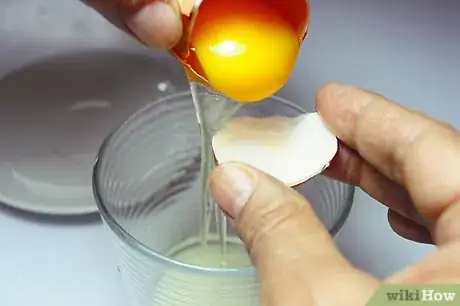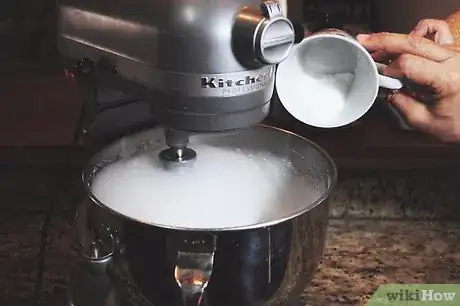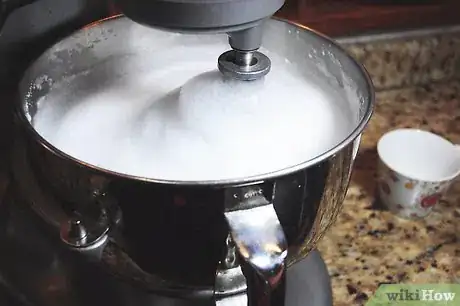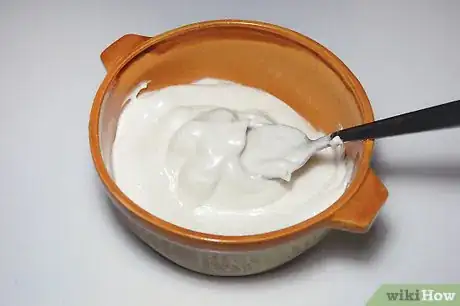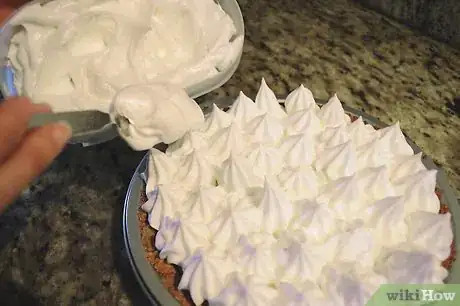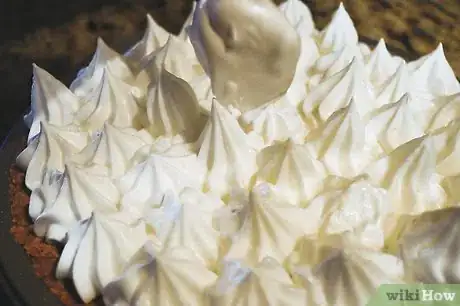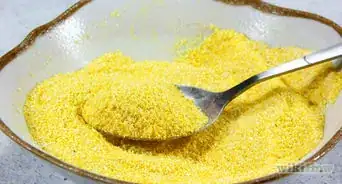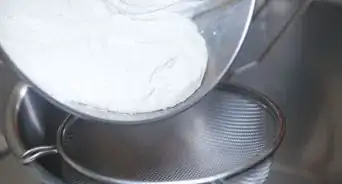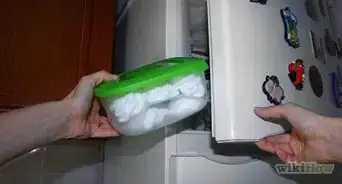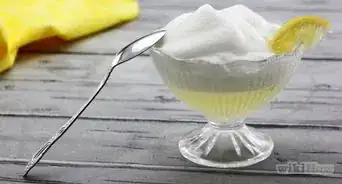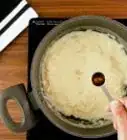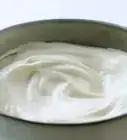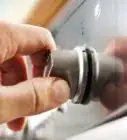This article was co-authored by wikiHow Staff. Our trained team of editors and researchers validate articles for accuracy and comprehensiveness. wikiHow's Content Management Team carefully monitors the work from our editorial staff to ensure that each article is backed by trusted research and meets our high quality standards.
This article has been viewed 87,180 times.
Learn more...
Meringue is a light, tasty and sweet concoction that is used as a dramatic topping for pies like lemon meringue and coconut cream. It's made from egg whites whipped with sugar: simple as that. Meringue isn't hard to make, but it adds a gourmet touch to the dessert table. See Step 1 and beyond to find out how to make it.
Ingredients
- 4 egg whites
- 1 cup granulated sugar
Steps
Getting Ready to Make Meringue
-
1Wait for a dry day. Meringue is made by beating air into egg whites, causing them to gain volume and become light and fluffy. The texture of meringue is best when the air is dry, because the presence of water can weigh it down. On rainy or humid days, the air contains higher water content. That's why meringue is easier to make and gains the right volume and texture when you make it on a dry day, rather than a rainy one.
- On rainy days, try beating the meringue longer so it's less likely to collapse.
-
2Use clean stainless steel or glass equipment. Bowls made from plastic are harder to clean, and they often have traces of oil and other materials that can affect the quality of the meringue. Use clean, dry stainless steel or glass bowls and utensils to make meringue.
- Even a drop or two of water can ruin a meringue, so make extra sure the bowl is dry.
Advertisement -
3Use older eggs. The texture of egg whites changes as the eggs age, becoming thinner. Eggs that are 3 or 4 days old whip up better than those that are extremely fresh. If you get your eggs from the supermarket, chances are they're already a few days old by the time you buy them, so they're probably fine. If you shop at the farmer's market, ask after the eggs' age so you know when to use them.[1]
-
4Separate the eggs. You can use an egg separator or do it by hand. Meringue doesn't require egg yolks, so set those aside and use them to custard or ice cream. The quickest way to separate eggs is to do the following:
- Hold an egg over a clean stainless steel or glass bowl.
- Crack the egg on the rim of the bowl, letting the white fall into the bowl.
- Carefully separate the egg halves and pass the yolk from half to half, letting the white drop down. Continue until the white is in the bowl and all you have left is the yolk.
- If you still need practice with this technique, separate each egg into a small container and pour the white into the larger mixing bowl you're using. That way you won't ruin a whole batch of egg whites by accidentally dropping in the yolk of the last egg you crack.
-
5Bring them to room temperature. Room temperature egg whites will get bigger and more voluminous when you whip them. Let them come to room temperature for a few minutes instead of beating them while they're still cold from the refrigerator.
Whipping the Egg Whites
-
1Beat them to form soft peaks. Use an electric mixer to start beating the egg whites in the mixing bowl. Keep beating them for several minutes, until they foam up and gain volume. Keep going until the whites have formed into soft, floppy peaks that will hold their shape but are in no way stiff.
- The egg whites should be in a large, tall bowl and the mixer set to medium-high speed.[2]
- Beating egg whites by hand is possible, but it takes much, much longer than using a mixer, and it's impossible to achieve the same texture.
- If you're making meringue cookies, you'll need to add cream of tartar and other flavorings at this point in the process.
-
2Add sugar slowly. Keeping the mixer running, add the sugar a few teaspoons at a time. It will slowly dissolve in the egg whites, causing them to become stiff and glossy. Keep adding the sugar until you've used as much as you want, and keep beating until it's dissolved.
- Most meringue recipes call for 1/4 cup of sugar for every egg white.
- If you want a softer meringue, add less sugar. You can add as little as 2 tablespoons (29.6 ml) per egg white. For a stiffer meringue, add more sugar. It will give the meringue structure and gloss.
-
3Keep beating until the peaks are stiff and glossy. Eventually the egg whites will stiffen and take on a glossy sheen. Rub a bit of meringue between your fingers; if it's grainy, that means you need to keep beating for a few more minutes to let the sugar finish dissolving. If it's smooth, the meringue is ready to be baked.
- Another way to tell if meringue is ready is to dip a spoon in the mixture and hold it upside down; if it slips off the spoon, keep beating. If it sticks, it's probably ready.
Baking Meringue
-
1Make the meringue before the filling. This gives it a little time to set before you top the pie, which will help it stick during the baking process. Here are a few delicious recipes for pies that call for a meringue topping:
- Lemon meringue pie
- Coconut cream pie
- Raspberry meringue pie
- Lemon cream pie
-
2Spread the meringue over hot pie filling. Have the pie crust filled with hot filling ready for the meringue. Spoon it onto the filling and spread it evenly. Keep going until you have a great heap of meringue on top of the pie.
- Make sure the meringue completely covers the filling, all the way to the edge of the crust. This helps ensure it won't slide off as it bakes.
- Many bakers mound the meringue so that it forms a hill in the middle of the pie. This has a pretty effect when you cut the pie.
-
3Make meringue curls. Use the back of a spoon to dip into the meringue and lift it up, allowing it to form curls and peaks. This is a popular way to make the meringue look more decorative.
-
4Bake the meringue at a low temperature. Every pie recipe is a little different, but most will tell you to bake the meringue at about 325 °F (163 °C) for 20 or 30 minutes, so it has time to bake and set without burning. It's ready when a cooking thermometer reads 160 degrees.
Community Q&A
Did you know you can get answers researched by wikiHow Staff?
Unlock staff-researched answers by supporting wikiHow
-
QuestionMy meringue was too soft, what happened?
 wikiHow Staff EditorThis answer was written by one of our trained team of researchers who validated it for accuracy and comprehensiveness.
wikiHow Staff EditorThis answer was written by one of our trained team of researchers who validated it for accuracy and comprehensiveness.
Staff Answer wikiHow Staff EditorStaff AnswerThis happens when the humidity is too high. Meringues need to be made in low humidity, during dry weather. Next time, try turning off the oven but letting the meringues cool in the oven to keep it dry. Store meringues in an airtight container to prevent humidity from damaging them after baking. It is also important to make meringues on a dry, sunny day; the softness is more likely to happen when it's raining or muggy.
wikiHow Staff EditorStaff AnswerThis happens when the humidity is too high. Meringues need to be made in low humidity, during dry weather. Next time, try turning off the oven but letting the meringues cool in the oven to keep it dry. Store meringues in an airtight container to prevent humidity from damaging them after baking. It is also important to make meringues on a dry, sunny day; the softness is more likely to happen when it's raining or muggy. -
QuestionWhat temperature should the eggs be?
 wikiHow Staff EditorThis answer was written by one of our trained team of researchers who validated it for accuracy and comprehensiveness.
wikiHow Staff EditorThis answer was written by one of our trained team of researchers who validated it for accuracy and comprehensiveness.
Staff Answer wikiHow Staff EditorStaff Answer
wikiHow Staff EditorStaff Answer -
QuestionMy meringues always seem to crack during baking. What should I do next time?
 wikiHow Staff EditorThis answer was written by one of our trained team of researchers who validated it for accuracy and comprehensiveness.
wikiHow Staff EditorThis answer was written by one of our trained team of researchers who validated it for accuracy and comprehensiveness.
Staff Answer wikiHow Staff EditorStaff AnswerCracking can happen from being whisked at too high a rate, which creates large air bubbles that forces an uneven rise and spread, resulting in cracking. Or, it can be caused by cooking the meringues at too high a temperature. Next time, lower your mixer speed to medium and reduce the oven temperature a little so the meringues don't cook as quickly.
wikiHow Staff EditorStaff AnswerCracking can happen from being whisked at too high a rate, which creates large air bubbles that forces an uneven rise and spread, resulting in cracking. Or, it can be caused by cooking the meringues at too high a temperature. Next time, lower your mixer speed to medium and reduce the oven temperature a little so the meringues don't cook as quickly.
Things You'll Need
- Mixing bowl (steel or glass)
- Mixer
- Pie recipe
References
About This Article
To make meringue, first crack 2 large eggs and separate the whites and yolks into two bowls. Then, set aside the yolks for use in a different recipe and let the whites come to room temperature for 30 minutes. Using room temperature egg whites will help you whip higher, fluffier meringue. Add the egg whites to a large bowl, then sprinkle in ¼ teaspoon (1 g) of cream of tartar, which will help stabilize your meringue. You can use ½ teaspoon (2 ½ mL) of lemon juice if you don’t have cream of tartar. Beat the egg whites with a hand or stand mixer until they’re foamy and start to thicken. Next, add ½ cup (100 g) of sugar, 1 tablespoon (12 ½ g) at a time, beating after each addition. Finally, continue beating the meringue until stiff peaks form. You’ll know it’s done when the egg white peaks stand straight up on the beater when you lift it out of the bowl. To learn how to choose the best kind of eggs when making meringue, read on!



